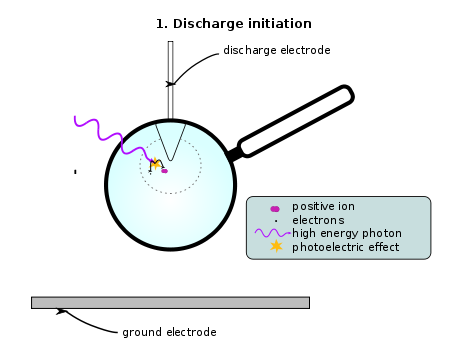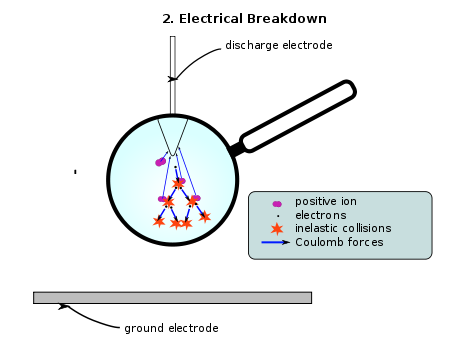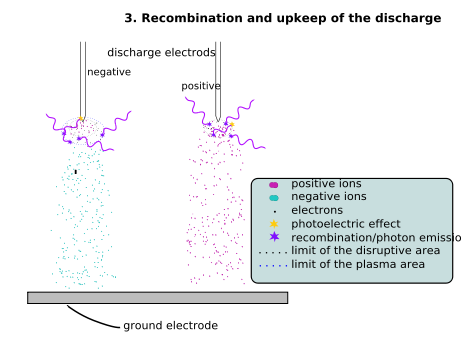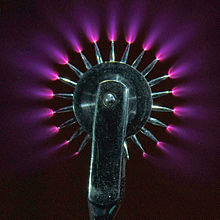- Corona discharge
-
In electricity, a corona discharge is an electrical discharge brought on by the ionization of a fluid surrounding a conductor that is electrically energized. The discharge will occur when the strength (potential gradient) of the electric field around the conductor is high enough to form a conductive region, but not high enough to cause electrical breakdown or arcing to nearby objects.
Contents
Introduction
A corona is a process by which a current, perhaps sustained, develops from an electrode with a high potential in a neutral fluid, usually air, by ionizing that fluid so as to create a plasma around the electrode. The ions generated eventually pass charge to nearby areas of lower potential, or recombine to form neutral gas molecules.
When the potential gradient is large enough at a point in the fluid, the fluid at that point ionizes and it becomes conductive. If a charged object has a sharp point, the air around that point will be at a much higher gradient than elsewhere. Air near the electrode can become ionized (partially conductive), while regions more distant do not. When the air near the point becomes conductive, it has the effect of increasing the apparent size of the conductor. Since the new conductive region is less sharp, the ionization may not extend past this local region. Outside this region of ionization and conductivity, the charged particles slowly find their way to an oppositely charged object and are neutralized.
If the geometry and gradient are such that the ionized region continues to grow instead of stopping at a certain radius, a completely conductive path may be formed, resulting in a momentary spark, or a continuous arc.
Corona discharge usually involves two asymmetric electrodes; one highly curved (such as the tip of a needle, or a small diameter wire) and one of low curvature (such as a plate, or the ground). The high curvature ensures a high potential gradient around one electrode, for the generation of a plasma.
Coronas may be positive or negative. This is determined by the polarity of the voltage on the highly-curved electrode. If the curved electrode is positive with respect to the flat electrode we say we have a positive corona, if negative we say we have a negative corona. (See below for more details.) The physics of positive and negative coronas are strikingly different. This asymmetry is a result of the great difference in mass between electrons and positively charged ions, with only the electron having the ability to undergo a significant degree of ionising inelastic collision at common temperatures and pressures.
An important reason for considering coronas is the production of ozone around conductors undergoing corona processes in air. A negative corona generates much more ozone than the corresponding positive corona.
Applications of corona discharge
Corona discharge has a number of commercial and industrial applications.
- Drag reduction over a flat surface
- Removal of unwanted electric charges from the surface of aircraft in flight and thus avoiding the detrimental effect of uncontrolled electrical discharge pulses on the performance of avionic systems
- Manufacture of ozone
- Sanitization of pool water
- Scrubbing particles from air in air-conditioning systems (see electrostatic precipitator)
- Removal of unwanted volatile organics, such as chemical pesticides, solvents, or chemical weapons agents, from the atmosphere
- Improvement of wetability or 'surface tension energy' of polymer films to improve compatibility with adhesives or printing inks
- Photocopying
- Air ionisers
- Production of photons for Kirlian photography to expose photographic film
- EHD thrusters, Lifters, and other ionic wind devices
- Nitrogen laser
- Surface treatment for tissue culture (polystyrene)
- Ionization of a gaseous sample for subsequent analysis in a mass spectrometer or an ion mobility spectrometer
- Solid-state cooling components for computer chips (see solid-state fan)
Coronas can be used to generate charged surfaces, which is an effect used in electrostatic copying (photocopying). They can also be used to remove particulate matter from air streams by first charging the air, and then passing the charged stream through a comb of alternating polarity, to deposit the charged particles onto oppositely charged plates.
The free radicals and ions generated in corona reactions can be used to scrub the air of certain noxious products, through chemical reactions, and can be used to produce ozone.
Problems caused by corona discharges
Coronas can generate audible and radio-frequency noise, particularly near electric power transmission lines. They also represent a power loss, and their action on atmospheric particulates, along with associated ozone and NOx production, can also be disadvantageous to human health where power lines run through built-up areas. Therefore, power transmission equipment is designed to minimise the formation of corona discharge.
Corona discharge is generally undesirable in:
- Electric power transmission, where it causes:
- Power loss
- Audible noise
- Electromagnetic interference
- Purple glow
- Ozone production
- Insulation damage
- Inside electrical components such as transformers, capacitors, electric motors and generators. Corona progressively damages the insulation inside these devices, leading to premature equipment failure. One form of attack is ozone cracking of elastomer items like O-rings.
- Situations where high voltages are in use, but ozone production is to be minimised
- Static electricity discharge
Coronas can be suppressed by corona rings, toroidal devices that serve to spread the electric field over larger area and decrease the field gradient below the corona threshold.
Mechanism of corona discharge
Corona discharge of both the positive and negative variety have certain mechanisms in common.
- A neutral atom or molecule of the medium, in a region of strong electric field (such as the high potential gradient near the curved electrode) is ionized by an exogenous environmental event (for example, as the result of a photon interaction), to create a positive ion and a free electron.

- The electric field then operates on these charged particles, separating them, and preventing their recombination, and also accelerating them, imparting each of them with kinetic energy.
- As a result of the energisation of the electrons (which have a much higher charge/mass ratio and so are accelerated to a higher velocity), further electron/positive-ion pairs may be created by collision with neutral atoms. These then undergo the same separating process creating an electron avalanche. Both positive and negative coronas rely on electron avalanches.

- In processes which differ between positive and negative coronas, the energy of these plasma processes is converted into further initial electron dissociations to seed further avalanches.
- An ion species created in this series of avalanches (which differs between positive and negative coronas) is attracted to the uncurved electrode, completing the circuit, and sustaining the current flow.

The onset voltage of corona or corona inception voltage (CIV) can be found with Peek's law (1929), formulated from empirical observations. Later papers derived more accurate formulas.
Electrical properties
The current carried by the corona is determined by integrating the current density over the surface of the conductor. The power loss is determined by multiplying the current by the voltage.
Positive coronas
Properties
A positive corona is manifested as a uniform plasma across the length of a conductor. It can often be seen glowing blue/white, though many of the emissions are in the ultraviolet. The uniformity of the plasma owes itself to the homogeneous source of secondary avalanche electrons described in the mechanism section, below. With the same geometry and voltages, it appears a little smaller than the corresponding negative corona, owing to the lack of a non-ionising plasma region between the inner and outer regions. There are many fewer free electrons in a positive corona, when compared to a negative corona, except very close to the curved electrode: perhaps a thousandth of the electron density, and a hundredth of the total number of electrons.
However, the electrons in a positive corona are concentrated close to the surface of the curved conductor, in a region of high-potential gradient (and therefore the electrons have a high energy), whereas in a negative corona many of the electrons are in the outer, lower-field areas. Therefore, if electrons are to be used in an application which requires a high activation energy, positive coronas may support a greater reaction constants than corresponding negative coronas; though the total number of electrons may be lower, the number of a very high energy electrons may be higher.
Coronas are efficient producers of ozone in air. A positive corona generates much less ozone than the corresponding negative corona, as the reactions which produce ozone are relatively low-energy. Therefore, the greater number of electrons of a negative corona leads to an increased production.
Beyond the plasma, in the unipolar region, the flow is of low-energy positive ions toward the flat electrode.
Mechanism
As with a negative corona, a positive corona is initiated by an exogenous ionisation event in a region of high potential gradient. The electrons resulting from the ionisation are attracted toward the curved electrode, and the positive ions repelled from it. By undergoing inelastic collisions closer and closer to the curved electrode, further molecules are ionized in an electron avalanche.
In a positive corona, secondary electrons, for further avalanches, are generated predominantly in the fluid itself, in the region outside the plasma or avalanche region. They are created by ionization caused by the photons emitted from that plasma in the various de-excitation processes occurring within the plasma after electron collisions, the thermal energy liberated in those collisions creating photons which are radiated into the gas. The electrons resulting from the ionisation of a neutral gas molecule are then electrically attracted back toward the curved electrode, attracted into the plasma, and so begins the process of creating further avalanches inside the plasma.
As can be seen, the positive corona is divided into two regions, concentric around the sharp electrode. The inner region contains ionising electrons, and positive ions, acting as a plasma, the electrons avalanche in this region, creating many further ion/electron pairs. The outer region consists almost entirely of the slowly migrating massive positive ions, moving toward the uncurved electrode along with, close to the interface of this region, secondary electrons, liberated by photons leaving the plasma, being re-accelerated into the plasma. The inner region is known as the plasma region, the outer as the unipolar region.
Negative coronas
Properties
A negative corona is manifested in a non-uniform corona, varying according to the surface features and irregularities of the curved conductor. It often appears as tufts of corona at sharp edges, the number of tufts altering with the strength of the field. The form of negative coronas is a result of its source of secondary avalanche electrons (see below). It appears a little larger than the corresponding positive corona, as electrons are allowed to drift out of the ionising region, and so the plasma continues some distance beyond it. The total number of electrons, and electron density is much greater than in the corresponding positive corona. However, they are of a predominantly lower energy, owing to being in a region of lower potential-gradient. Therefore, whilst for many reactions the increased electron density will increase the reaction rate, the lower energy of the electrons will mean that reactions which require a higher electron energy may take place at a lower rate.
Mechanism
Negative coronas are more complex than positive coronas in construction. As with positive coronas, the establishing of a corona begins with an exogenous ionization event generating a primary electron, followed by an electron avalanche.
Electrons ionized from the neutral gas are not useful in sustaining the negative corona process by generating secondary electrons for further avalanches, as the general movement of electrons in a negative corona is outward from the curved electrode. For negative corona, instead, the dominant process generating secondary electrons is the photoelectric effect, from the surface of the electrode itself. The work-function of the electrons (the energy required to liberate the electrons from the surface) is considerably lower than the ionization energy of air at standard temperatures and pressures, making it a more liberal source of secondary electrons under these conditions. Again, the source of energy for the electron-liberation is a high-energy photon from an atom within the plasma body relaxing after excitation from an earlier collision. The use of ionized neutral gas as a source of ionization is further diminished in a negative corona by the high-concentration of positive ions clustering around the curved electrode.
Under other conditions, the collision of the positive species with the curved electrode can also cause electron liberation.
The difference, then, between positive and negative coronas, in the matter of the generation of secondary electron avalanches, is that in a positive corona they are generated by the gas surrounding the plasma region, the new secondary electrons travelling inward, whereas in a negative corona they are generated by the curved electrode itself, the new secondary electrons travelling outward.
A further feature of the structure of negative coronas is that as the electrons drift outwards, they encounter neutral molecules and, with electronegative molecules (such as oxygen and water vapor), combine to produce negative ions. These negative ions are then attracted to the positive uncurved electrode, completing the 'circuit'.
A negative corona can be divided into three radial areas, around the sharp electrode. In the inner area, high-energy electrons inelastically collide with neutral atoms and cause avalanches, whilst outer electrons (usually of a lower energy) combine with neutral atoms to produce negative ions. In the intermediate region, electrons combine to form negative ions, but typically have insufficient energy to cause avalanche ionization, but remain part of a plasma owing to the different polarities of the species present, and the ability to partake in characteristic plasma reactions. In the outer region, only a flow of negative ions and, to a lesser and radially-decreasing extent, free electrons toward the positive electrode takes place. The inner two regions are known as the corona plasma. The inner region is an ionizing plasma, the middle a non-ionizing plasma. The outer region is known as the unipolar region.
Examples
Corona discharge may be seen around automotive spark plug wires that have become worn.
See also
- Atmospheric pressure chemical ionization
- Dielectric barrier discharge
- Kirlian photography
- Ozone
- Ozone cracking
- St. Elmo's fire
References
- Junhong Chen, "Direct-Current Corona Enhanced Chemical Reactions", Ph.D. Thesis, University of Minnesota, USA. August 2002.
- F.W. Peek (1929). Dielectric Phenomena in High Voltage Engineering. McGraw-Hill. ISBN 0-9726596-6-8. http://www.ee.vill.edu/ion/p183.html.
- Leonard Loeb (1965). Electrical Coronas Their Basic Physical Mechanisms. University of California Press.
- James D. Cobine (1941, reprints in 1958, 1970)). Gaseous Conductors; Theory and Engineering Applications. McGraw-Hill or Dover reprints.
External links
- Blaze Labs Research — Lots of information on corona properties & Peek's Law
- Villanova University — Modelling Corona for different electrode configurations
- Information about the differences between corona, spark, and brush discharges
- Additional information about corona, its effects, characteristics and preventative measures
- Dielectric Phenomena In High Voltage Engineering
Categories:- Electrical breakdown
- Plasma physics
Wikimedia Foundation. 2010.


